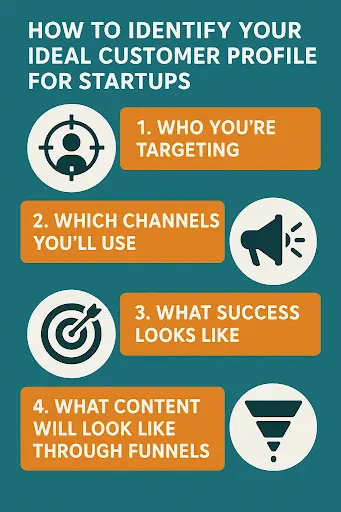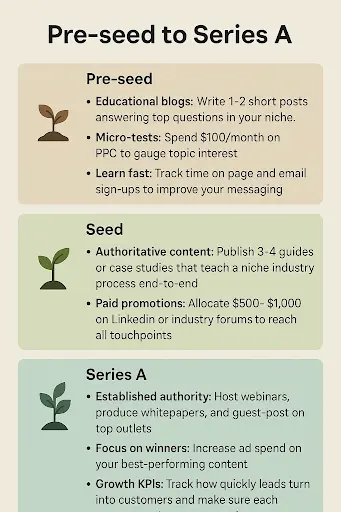Digital Marketing for Startups: Growth Strategies that Actually Work

According to research, a majority of founders are hesitant to use high-yielding digital marketing strategies for early-stage brand growth.
The reason is not that digital marketing is difficult, but that there is a gap between amateur understanding of marketing and what it can actually offer. For example, beginner founders often confuse B2B and B2C campaigns, relying on lead magnets when they need interactive marketing.
Solid digital marketing for startups picks the right channels at each customer journey, runs quick, low-cost tests, and doubles down on what works.
In this guide, you’ll get stage-based roadmaps, low-profit tactics, and simple checkpoints to keep you on track. Let’s see how you can refrain from failing at marketing as a startup.
What does a Digital Marketing Strategy Really Mean for a Startup?
Starting out, many founders rush into every tactic without knowing how to do market research for a startup, so they copy big-brand architecture. This leads to spreading out resources too thin and losing sight of the product.
Research found that 60% of marketing budgets are wasted due to inefficiencies in execution and planning.

Instead, creating a playbook before you decide on your budget can increase the chances of success. The playbook must include finding, engaging, and converting the customers who matter most: your Ideal Customer Profile (ICP). It’s a focused plan that spells out:
1. Who you’re targeting
Define your ICP by role, industry, budget, and pain points. The sharper your persona, the less wasted spend you’ll generate.
2. Which channels you’ll use
Decide between organic (SEO, content, social) and paid (PPC, paid social, display) marketing. Early on, lean on the lowest-cost, highest-result tests, and then you can always scale what works.
3. What success looks like
Set simple performance metrics: clicks, leads, demo requests, etc. Tie each channel back to those goals.
4. What content will look like through funnels
Every marketing piece you approve should target a part of the sales funnel (awareness, interest, consideration, conversion).
Stage-Based Roadmap: Pre-Seed vs. Seed vs. Series A
Here’s a clear roadmap that aligns your marketing activities with each funding stage. You’ll see exactly where and when to invest effort, budget, and analysis to educate your audience and measure growth.

Pre-seed
-
Educational blogs: Write 1-2 short posts answering top questions in your niche.
-
Micro-tests: Spend $100/month on PPC to gauge topic interest.
-
Learn fast: Track time on page and email sign-ups to improve your messaging.
Seed
-
Authoritative content: Publish 3-4 guides or case studies that teach a niche industry process end-to-end.
-
Paid promotions: Allocate $500-$1,000 on LinkedIn or industry forums to reach all touchpoints.
-
Lead metrics: Measure demo requests and Marketing Qualified Leads (MQLs) to see which topics capture attention.
Series A
-
Established authority: Host webinars, produce whitepapers, and guest-post on top outlets.
-
Focus on winners: Increase ad spend on your best-performing content.
-
Growth KPIs: Track how quickly leads turn into customers and make sure each customer brings in more value than it costs to get them.
The startup marketing action plan
| Stage | Weeks | Task | Goal | Action Plan in the Making |
|---|---|---|---|---|
| Pre-seed | 1–4 | • Write 2 educational blogs <br> • Run a $100 PPC test <br> • Track engagement metrics | Validate messaging and demand | • Sketch blog topics <br> • Set up a PPC account |
| Seed | 5–6 | • Publish in-depth guides/case studies <br> • Boost key posts ($500–$1,000) <br> • Measure MQLs & demos | Identify high-ROI social media content | • Outline guide formats <br> • Create LinkedIn ad deck |
| Series A | 7–8 | • Host a webinar <br> • Produce a whitepaper <br> • Launch referral loop | Scale authority and referrals | • Book a webinar speaker <br> • Draft referral flow |
Core Digital Marketing Growth Tactics for Startups
Of 1000 businesses surveyed, 78% wished to invest more in digital marketing. Despite this, only 7% of startups agreed to spending 24 hours per week on marketing. Understandably, startups running their own digital marketing might not have the time. Which is why having a plan in place is necessary.

Below are five high-impact digital marketing tactics (and tools to use) you can launch without wasting too much time planning. Each is framed as a repeatable sprint or campaign. No wasted effort, just clear steps to grow.
1. Hyper-targeted SEO for blogs and landing pages
Begin with three to five core terms your ideal customers type into Google. Over the next four weeks, build one deep “pillar” article and a handful of shorter posts that answer related questions.
Must do: Link each child piece back to your main pillar. This internal linking tells Google you know what you’re writing about.
Tools you can use: Track SEO and generative engine optimisation progress in Google Search Console and Ahrefs, then use Surfer SEO to change underperforming keywords.
2. Founder-led social for trust and authority building
Direct interaction with C-suites and SMEs is growing, with 51% of them saying they spend over an hour each week reading and reviewing thought leaders. Choose the channel your ICP interacts with the most (LinkedIn for B2B, YouTube for Tech) and share genuine expert opinions every week.
Marketing ideas for startups and founders: A product decision that surprised you, a breakdown of new releases, or a reaction to industry news (all without directly promoting your service). Spend 10 minutes daily replying to target accounts. Comments turn into conversations and, eventually, demos.
Tools to use: Use Feedly or trending news on X to find relevant articles, draft posts in Buffer or WordPress, and schedule them at peak times.
3. PPC micro-tests to eliminate underperformers
Before you commit a big ad budget, run a tight $200-$300 test on Google Ads or Facebook Ads Manager. Focus on one headline or image, and send traffic to an Unbounce or Instapage landing page with a single call-to-action.
What to do next: Measure click-through and cost-per-lead (CPL). If your CPL beats your benchmark, double the budget. If it’s below average, improve the content, narrow the target audience, and try again.
4. Warm-up email drip with story arcs
Cold sign-ups need a story, not a sales pitch. According to Mailchimp, the best way to improve open rates is to craft a compelling subject line.
Some more tips: Segment contacts by interest, say “market research” vs. “growth hacks”, then send automated email sequences over three weeks. Start with a founder anecdote, follow with two practical tips, share a mini case study, and close with an invite to a demo or exclusive guide.
Helpful tools: Kit handles the automation, while Lemlist adds personalised touches.

5. Repurposing long-form content for every touchpoint
Turn every blog post, webinar, or podcast into smaller content. A one-hour video can make 10 LinkedIn posts. Repurposing is the secret to saving time and effort in digital marketing for startups.
Proper repurposing: Start by pulling key quotes, stats, or tips from your long-form piece and turn each into a LinkedIn carousel, X thread, or Instagram reel. This approach stretches your effort, keeps your brand top-of-mind, and meets your audience where they scroll.
Simple tools: Canva has every social layout ratio. Use Descript to pull audio snippets into short videos or audio. Export webinar recordings into blog posts or FAQs with Evernote.
Automate your marketing for social clips with Repurpose.io so every new asset feeds Facebook, LinkedIn, and YouTube without extra work.
Digital Marketing Strategies for Crisis Communication
Startups face double the damage in a crisis: limited resources and lower brand credibility mean any rumour can quickly lose the audience's trust. To stay ahead, build a simple, pre-approved plan that includes:
-
Monitoring: Use Brandwatch to catch negative comments before they spiral into reposts.
-
Transparency: Have pre-written templates acknowledging issues. Add in explanations on what you’re doing, and set clear expectations.
-
Direct outreach: Send an email to your customers, addressing concerns head-on rather than waiting for them to ask.
-
Team alignment: Keep spokespeople on Slack or Teams, with talking points ready to go.
Digital Marketing for Startups: Top 3 Trends to Follow in 2025
Startups have been creating personalised experiences using AI to save marketing budget. For instance, Klarna, a fintech startup, saves $10M annually on marketing by using an internal AI assistant. It’s proven an asset for personalising content, recommendations, and chatbot responses so every user feels like you built your startup just for them.

Consumers are more aware than ever about their digital privacy. They rely on honest, opt-in analytics and cookieless engagement. Startups putting privacy first and being open about how they use data not only avoid legal issues, but also build real trust.
Consumers have also started preferring short-form, interactive content like 30-60-second clips, polls, and shoppable moments on Reels or Shorts. Having a mobile-friendly UX design gives brands an edge so their customers can access everything at their fingertips.
Your Turn to Shine: Pick a Digital Marketing Strategy for Startups
We’ve shown how focused digital marketing for startups cut wasted spend, brings real engagement, and brings growth at every funding stage.
But none of that matters without the right data. Making every decision, from choosing the channels that match your ICP to running tests and doubling down on winners, data tells you what’s working, what to change, and where to invest next.
That’s why platforms like intellsys are revolutionary for growth marketers. By combining all your data, from collection and analysis to insight activation, Intellsys ensures every campaign is backed by real-time intelligence.
With the right tools and a partner like GrowthJockey, your startup marketing can move from shot-in-the-dark strategies to an engine that converts customers and impresses investors.
FAQs on Digital Marketing for Startups
1. Which digital strategy has the highest ROI?
In digital marketing for startups, email marketing and SEO both have high value in ROI. Depending on your startup’s marketing requirements, you can decide between the two. Here are some of the benefits each offers:
-
SEO is better for long-term growth, while email reaches a wider audience
-
SEO brings in new leads, while email nurtures and retains leads
-
SEO is better for sales, while email is better for customer experience
2. How to promote a startup?
Promote a startup by combining targeted, cost-effective channels with authentic storytelling.
-
Start with market research and define your ICP
-
Publish educational content on blogs and social media
-
Run small PPC tests to validate messaging, and leverage founder-led engagement for credibility
-
Repurpose your content and turn long content into different segments on different mediums.
3. Do small businesses need digital marketing?
Small businesses absolutely need digital marketing to remain competitive and visible. Even a basic presence on search engines, social media, and email builds credibility and accessibility.
Measurable tactics, like SEO, content marketing, and low-budget PPC, let you hit local and niche audiences efficiently. Digital marketing bridges the gap between you and potential customers.
4. How to start marketing for a startup?
To start marketing for a startup, begin by defining your ICP and conducting thorough market research, and know your audience’s pain points. Set clear goals and choose two to three channels to test: SEO, content, social, or PPC. Create a simple playbook outlining content topics, budgets, and success metrics. Experiment, measure performance, and repeat.








